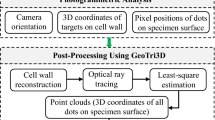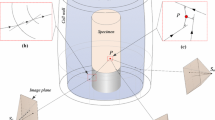Abstract
A quantitative analysis method for reconstructing the spatial movement of gravels in a triaxial mixed soil specimen is proposed. CT scanning and numerical modeling methods were applied to establish a true three-dimensional numerical model based on triaxial testing of mixed soil. Point set data of each gravel was generated according to surface nodes of the gravel. The point set data was used to calculate the spatial movement of the gravels, including the changes in spatial position and spatial attitude, by using the iterative closest point (ICP) algorithm. There were no obvious contacts between the gravels because the gravel content was low. The deformation of the surrounding soil played a controlling role in the movement of the gravel. The axial displacement of gravels was largest in the upper part of the specimen, and decreased from the top to the bottom of the specimen. Generally, the lateral displacement of gravels near the outside of the specimen was greater than that of the gravels close to the axis. Rotation of the gravels was found during the triaxial test, which indicates that changes in the spatial attitude of the gravels occurred. The movement of the gravels was consistent with the testing method, in which the load was applied on the top of the specimen, and the movement also agreed with the macro-deformation of the triaxial specimen. The above movement characteristics of gravels proved that the proposed method is valid for the quantitative description of changes in spatial position and spatial attitude.








Similar content being viewed by others
References
Besl PJ, McKay ND (1992) A method for registration of 3-D shapes. IEEE Transactions on Pattern Analysis and Machine Intelligence - Special issue on interpretation of 3-D scenes—part II archive 14(2):239–256
Coli N, Berry P, Boldini D, Bruno R (2012) The contribution of geostatistics to the characterisation of some bimrock properties. Eng Geol 137–138:53–63
Coli N, Berry P, Boldini D (2011) In situ non-conventional shear tests for the mechanical characterisation of a bimrock. Int J Rock Mech Min Sci 48:95–102
Ding XL, Zhang HM, Huang SL, Lu B, Zhang Q (2012) Research on mechanical characteristics of unsaturated soil-rock mixture based on numerical experiments of Mesostructure. Chinese J Rock Mech Eng 31(8):1553–1566 (in Chinese)
Jiang JW, Wei X, Joachim J, Markus S, Pan JJ, Zhang W (2016) Research on mechanical parameters of coarse-grained sliding soil based on CT scanning and numerical tests. Landslides 13(5):1261–1272
Kalender A, Sonmez H, Medley E, Tunusluoglu C, Kasapoglu KE (2014) An approach to predicting the overall strengths of unwelded bimrocks and bimsoils. Eng Geol 183:65–79
Kahraman S, Alber M (2006) Estimating unconfined compressive strength and elastic modulus of a fault breccia mixture of weak blocks and strong matrix. Int J Rock Mech Min Sci 43:1277–1287
Lade P, Liggio CD, Yamamuro JA (1998) Effects of non-plastic fines on minimum and maximum void ratios of sand. Geotech Test J 21(4):336–347
Li X, Liao QL, He JM (2005) In-situ tests and a stochastic structural model of rock and soil aggregate in the three gorges reservoir area, China. Int J Rock Mech Min Sci 41(3):494–495
Li CS, Zhang D, Du SS, Shi B (2016) Computed tomography based numerical simulation for triaxial test of soil–rock mixture. Comput Geotech 73:179–188
Lindquist ES, Goodman RE (1994) Strength and deformation properties of a physical model melange. Proc. 1st North American Rock Mechanics Conf. (NARMS), Austin, pp 843–850
Medley EW (1994) The engineering characterization of melanges and similar block-in-matrix rocks (Bimrocks), Ph.D. Dissertation, Department of Civil Engineering, University of California at Berkeley
National Standard of the People's Republic of China, Code for Investigation of Geotechnical Engineering, GB 50021-2001, National Standard of the People's Republic of China, 2009, Date of Issue: 2002-01-10, Date of Implementation: 2002-03-01, Issued by: The Standardization Administration of the People's Republic of China
Tsesarsky M, Hazan M, Gal E (2016) Estimating the elastic moduli and isotropy of block in matrix (bim) rocks by computational homogenization. Eng Geol 200:58–65
Vallejo LE, Mawby R (2000) Porosity influence on the shear strength of granular material–clay mixtures. Eng Geol 58(2):125–136
Vallejo LE (2001) Interpretation of the limits in shear strength in binary granular mixtures. Can Geotech J 38(5):1097–1104
Wen BP, Aydin A, Duzgoren-Aydin NS, Li YR, Chen HY, Xiao SD (2007) Residual strength of slip zones of large landslides in the Three Gorges area, China. Eng Geol 93(3–4):82–98
Xu WJ, Hu RL, Tan RJ (2007) Some geomechanical properties of soil-rock mixtures in Tiger-leaping Gorge area, China. Géotechnique 57(3):255–264
Xu WJ, Xu Q, Hu RL (2011) Study on the shear strength of soil–rock mixture by large scale direct shear test. Int J Rock Mech Min Sci 48(8):1235–1247
Xu WJ, Wang S, Zhang HY, Zhang ZL (2016) Discrete element modelling of a soil-rock mixture used in an embankment dam. Int J Rock Mech Min Sci 86:141–156
Yue ZQ, Chen S, Tham LG (2003) Finite element modeling of geomaterials using digital image processing. Comput Geotech 30(5):375–397
You XH, Tang JS (2002) Research on horizontal push-shear in-situ test of soil and rock-mixture. Chinese J. Rock Mech. Eng. 21(10):1537–1540 (in Chinese)
Acknowledgments
The authors gratefully acknowledge the financial support provided by the National Natural Science Foundation of China (41572271, 41272315, 41772327).
Author information
Authors and Affiliations
Corresponding author
Rights and permissions
About this article
Cite this article
Zhang, D., Ji, T., Zheng, B. et al. Analysis method for spatial movement of gravels in mixed soil during triaxial testing. Bull Eng Geol Environ 80, 8861–8870 (2021). https://doi.org/10.1007/s10064-019-01573-4
Received:
Accepted:
Published:
Issue Date:
DOI: https://doi.org/10.1007/s10064-019-01573-4




